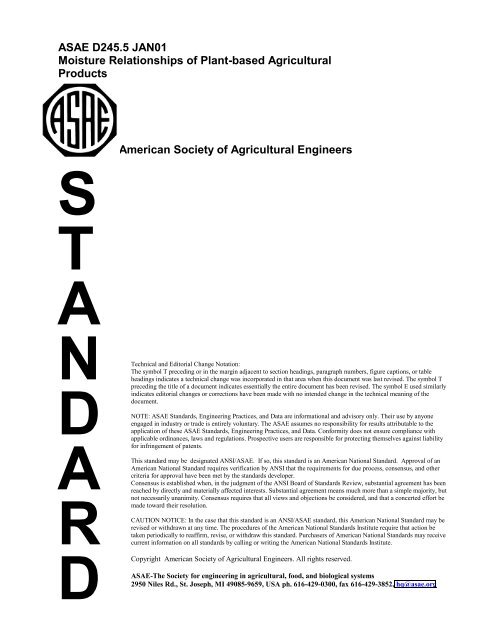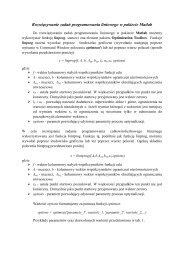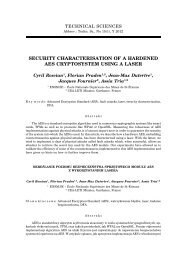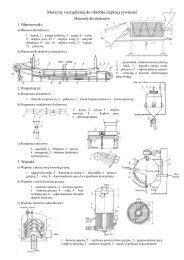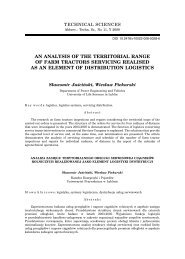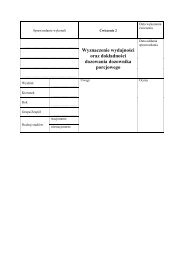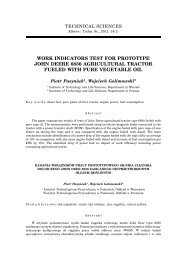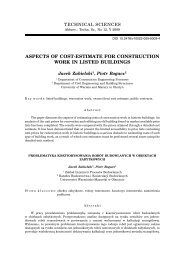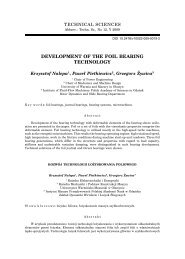Moisture Relationships of Plant-based Agricultural Products
Moisture Relationships of Plant-based Agricultural Products
Moisture Relationships of Plant-based Agricultural Products
You also want an ePaper? Increase the reach of your titles
YUMPU automatically turns print PDFs into web optimized ePapers that Google loves.
ASAE D245.5 JAN01<strong>Moisture</strong> <strong>Relationships</strong> <strong>of</strong> <strong>Plant</strong>-<strong>based</strong> <strong>Agricultural</strong><strong>Products</strong>Approved by the ASAE Committee on Technical Data; adopted by ASAE1948; revised 1954, 1962, 1964; revised by the Electric Power andProcessing Division Technical Committee 1968, April 1974, December1978; revised March 1980; reconfirmed December 1984, December1985; revised editorially by the Physical Properties <strong>of</strong> <strong>Agricultural</strong><strong>Products</strong> Committee; approved by the Food and Process EngineeringInstitute Standards Committee February 1989; reconfirmed December1990, December 1991; reaffirmed December 1992, December 1993;reaffirmed for one year December 1994; revised October 1995; revisededitorially March 1998; reaffirmed for one year January 2001.1 Purpose and scope1.1 This standard covers data and equations on plant-<strong>based</strong> agriculturalmaterials and their products. This standard does not cover information onanimal tissue and products.1.2 This standard gives data and equations on moisture relations foragricultural products. The information is used in crop drying calculationsand in design and analysis <strong>of</strong> storage systems for the material.1.3 The data and equations given in the standard are limited in theirrange <strong>of</strong> applicability. Extrapolation <strong>of</strong> the data beyond the range <strong>of</strong>applicability may give erroneous results.2 Normative referencesThe following standard contains provisions that, through reference in thistext, constitute provisions <strong>of</strong> this Standard. At the time <strong>of</strong> publication, theeditions indicated were valid. All standards are subject to revision, andparties to agreements <strong>based</strong> on this Standard are encouraged toinvestigate the possibility <strong>of</strong> applying the most recent edition <strong>of</strong> thestandard indicated below. Standards organizations maintain registers <strong>of</strong>currently valid standards.ASAE S352.2 DEC92, <strong>Moisture</strong> Management—Unground Grain andSeeds3 Wet-basis and dry-basis representationsWet-basis moisture contentMC W G WG DG W100%Dry-basis moisture content4 Conversion formulasMC WMC DG WG D100 MC D /100MC D 100 MC W /100MC W 100 G D /100MC W 100 G W /100MC D where MC W and MC D are in percent basis.5 Equilibrium moisture content—equilibrium relativehumidity dataTables 1a, 1b, 1c, and 1d list the experimentally recorded equilibriummoisture content (EMC)—equilibrium relative humidity (ERH) data forstarchy materials, fibrous materials and selected feedstuffs, materialshigh in oil and protein, and agricultural by-products, respectively, as wellas some background information on these data. Also, figures 1 through11 give graphical representation <strong>of</strong> the EMC-ERH data for mostcommonly utilized agricultural products.6 Isotherm equationsa. Modified Henderson equationRH1expA•TC•MC D B b. Modified Chung-Pfost equationRHexpATCDexpB•MCc. Modified Halsey equationRHexp expAB•TMC D Cd. Modified Oswin equationRH AB•T C 1MC D 1e. Guggenheim-Anderson-deBoer (GAB) equationA•B•C•RHMC D 1B•RH1B•RHB•C•RHwhere:where:MC D G WG DG D100%G W is mass <strong>of</strong> wet materialG D is mass <strong>of</strong> dry material (determined by the oven methodspecified in ASAE S352.2 or by an equivalent method)RH is relative humidityT is temperatureMC D is dry-basis moisture contentA,B,C are constants7 Isotherm equation constantsTable 2 lists isotherm equation constants and related data specifications<strong>based</strong> on which these constants were obtained.522 ASAE STANDARDS 2001
Table 1a – Equilibrium moisture content (EMC) and equilibrium relative humidity (ERH) data for starchy materials (continued)ProductDescriptionTemp(C) Path 1) EMC (% db) and ERH (%) 2) Source 3) Referencea2. Variety CSM5 10 Des ERH 11.2 34.2 40.0 57.8 75.2 81.7 95(a) Same as above(medium grain) EMC 8.0 12.0 12.8 16.3 19.6 21.320 Des ERH 11.2 23.2 33.6 43.9 54.9 65.3 75.5 86.6EMC 6.9 9.1 11.2 12.7 14.6 16.6 18.3 22.125 Des ERH 11.2 22.7 32.5 43.7 53.4 64.3 75.8 86.5EMC 6.2 8.6 10.4 11.9 13.7 15.3 18.1 20.930 Des ERH 11.2 22.0 32.8 43.6 52.0 63.3 75.6 86.3EMC 5.6 8.3 10.0 11.4 12.9 14.7 17.0 20.240 Des ERH 11.2 32.1 43.3 49.2 57.2 75.4 87.9EMC 4.7 8.8 10.2 11.3 12.1 15.6 18.9a3. Nipponbare 20 Des ERH 11.2 22.4 32.8 42.7 54.7 65.5 74.7 85.0 50(b) Same as above(short grain) EMC 6.1 8.8 10.7 12.4 14.0 16.1 18.8 21.030 Des ERH 21.6 32.1 42.5 50.7 62.8 75.4 83.4EMC 7.8 9.6 11.5 12.7 14.7 16.9 18.940 Des ERH 10.7 20.1 30.6 42.7 47.7 59.5 74.8 82.1EMC 5.0 7.0 8.7 10.5 11.4 13.2 15.7 17.6b. Brown rice b1. Nipponbare 20 Des ERH 11.6 23.7 34.0 44.5 56.9 68.3 77.6 87.8 50(b) 43,44(short grain) EMC 6.4 9.2 11.1 13.2 15.2 17.2 19.5 22.0→ (ERH) 10.0 20.0 30.0 40.0 50.0 60.0 70.0 80.0 90.0b2. Caloro 25 Mix EMC 6.2 8.0 9.5 10.9 12.3 13.5 14.8 16.2 19.1 44(a) 43,50c. Parboiled rice Variety Rexoro 25 Mix EMC 5.9 8.0 9.5 10.9 12.2 13.3 14.1 15.2 19.1 44(a) —38 Mix EMC 4.9 7.0 8.4 9.8 11.1 12.3 13.3 14.8 19.1d. Instant rice Long-grain 25 Mix EMC 5.5 7.4 8.9 9.7 10.5 11.5 13.1 15.4 20.1 44(a) —38 Mix EMC 3.7 5.5 7.0 8.2 9.2 10.3 11.7 13.8e. Milled rice Varienty Rexoro 25 Mix EMC 5.2 7.6 9.2 10.5 12.0 13.4 14.8 16.4 18.8 44(a) 9,527. Rye 25–28 Mix ERH 15.0 30.0 45.0 60.0 75.0 90.0 20(a) —EMC 7.5 9.6 11.7 13.9 17.4 25.98. Sorghum Kalir (ERH) 4.3 9.7 12.7 19.0 22.3 26.1 33.6 41.1 51.4 61.1 70.8 80.3 86.7 29(b) —4 Mix EMC 5.7 7.3 8.0 9.2 9.7 10.2 11.3 12.3 13.9 15.7 17.8 20.9 23.921 Mix EMC 4.5 6.4 7.1 8.4 9.0 9.5 10.5 11.5 12.9 14.6 18.4 19.1 21.632 Mix EMC 3.4 5.3 6.1 7.5 8.0 8.6 9.6 10.6 12.0 13.5 15.2 17.3 19.09. Wheat → (EMC) 9.9 11.1 13.6 16.3 19.0 22.0 25.0 28.2 31.6a. Durum Wakooma 5 Ads ERH 31.0 37.0 50.0 64.0 74.0 82.3 88.5 92.5 94.0 65(a) 20,25,28,67,(Canadian) 15 Ads ERH 34.0 40.0 53.5 66.7 76.5 83.5 89.0 92.5 94.0 86,88,9325 Ads ERH 36.0 42.5 57.0 69.5 78.0 84.5 89.5 92.5 94.05 Des ERH 26.7 33.0 47.0 61.5 72.5 81.5 88.5 92.5 94.015 Des ERH 29.5 36.0 50.0 64.0 74.5 83.5 89.0 92.5 94.025 Des ERH 32.5 39.0 54.5 68.0 77.3 84.5 89.5 92.5 94.0b. Hard red Sinton 5 Ads ERH 31.0 37.0 50.0 64.0 74.0 82.3 88.5 92.5 94.0 65(a) Same as abovespring (Canadian) 15 Ads ERH 34.0 40.0 53.5 66.7 76.5 83.5 89.0 92.5 94.025 Ads ERH 36.0 42.5 57.0 69.5 78.0 84.5 89.5 92.5 94.05 Des ERH 26.7 33.0 47.0 61.5 72.5 81.5 88.5 92.5 94.015 Des ERH 29.5 36.0 50.0 64.0 74.5 83.5 89.0 92.5 94.025 Des ERH 32.5 39.0 54.5 68.0 77.3 84.5 89.5 92.5 94.0c. Hard red Maris Huntsman 25 Ads ERH 25.6 47.3 67.0 82.4 87.3 92.8 38(b) Same as abovewinter (English) EMC 8.2 11.3 14.4 18.4 20.3 24.525 Des ERH 32.2 52.1 65.3 86.6 92.7EMC 9.6 12.5 14.7 20.5 25.5d. S<strong>of</strong>t winter Hobbit (English) 25 Ads ERH 23.5 42.8 63.3 82.5 93.3 38(b) Same as aboveEMC 8.7 11.6 14.3 19.1 25.125 Des ERH 22.2 38.6 58.5 84.8 92.0EMC 8.8 11.6 14.1 20.0 24.3e. White 25–28 Mix ERH 15.0 30.0 45.0 60.0 75.0 90.0 20(a) Same as aboveEMC 7.3 9.4 11.0 13.3 17.6 24.51) ‘Ads’—Adsorption; ‘Des’—Desorption; ‘Mix’—Mixture <strong>of</strong> adsorption and desorption2) ‘(ERH)’ or ‘(EMC)’ Indicates the same ERH or EMC corresponding to the multi-EMC or multi-ERH rows to follow for one single product ‘→’ indicates the ERH or EMCpointed corresponds to both multiple EMC or ERH rows next and multiple products below3) ‘(a)’—original data from reference; ‘(b)’—digitized values from figures in a referenceASAE STANDARDS 2001 525
Table 1b – Equilibrium moisture content (EMC) and equilibrium relative humidity (ERH) data for fibrous materials and selected feedstuffsProductDescriptionTemp(C) Path 1) EMC (% db) and ERH (%) 2) Source 3) Reference1. Pelletsa. Alfalfa pellet a1. 1/4 in. dehy 10 Mix ERH 14.5 29.3 33.2 46.7 56.2 65.2 71.3 83.2 90.0 96.1 28(b) —EMC 5.8 7.8 8.9 10.1 12.0 16.0 18.2 21.5 22.6 23.420 Mix ERH 13.0 16.1 31.0 46.2 57.2 64.1 76.2 80.0 88.9 95.2EMC 5.7 6.0 7.2 9.0 10.6 11.9 16.7 18.9 21.8 22.830 Mix ERH 12.5 12.7 27.2 34.2 47.2 58.2 67.5 77.1 85.0 92.1EMC 5.7 5.7 6.4 7.0 8.8 10.8 11.4 15.9 18.1 20.040 Mix ERH 12.9 26.2 33.7 47.2 52.1 62.7 70.2 78.2 87.3 96.7EMC 4.8 5.4 6.4 8.0 8.4 9.2 10.8 14.5 18.1 20.5a2. 5/16 in. suncure 10 Mix ERH 5.6 10.2 25.2 36.6 43.2 52.5 65.2 72.2 85.2 95.1EMC 5.5 6.1 7.5 8.9 9.5 11.2 13.6 16.4 20.6 22.420 Mix ERH 10.3 16.3 21.1 35.3 46.2 59.3 67.2 78.9 85.2 92.3EMC 5.5 6.1 6.4 7.8 9.9 12.2 14.3 18.5 20.2 21.330 Mix ERH 7.5 22.4 25.2 35.2 40.4 50.3 62.7 75.8 83.8 94.3EMC 4.7 5.6 5.8 7.6 8.1 10.8 11.6 15.9 19.5 17.940 Mix ERH 7.2 23.6 32.5 36.2 44.9 60.7 71.6 78.7 89.0 93.3EMC 4.4 5.1 6.1 7.1 4.7 10.6 12.4 14.4 20.0 20.8b. Laying mash 25 Ads ERH 14.1 24.0 39.8 50.9 63.3 77.5 86.9 11(b) —pellet EMC 6.1 7.3 9.4 10.7 13.3 18.4 28.945 Ads ERH 12.7 20.9 36.8 45.7 67.9 77.9 87.3EMC 4.4 6.1 7.6 8.7 12.6 16.7 27.565 Ads ERH 13.9 21.2 34.9 51.7 68.1 77.3 88.3EMC 3.9 4.9 6.6 8.5 11.6 15.1 27.32. Grass & hay → (ERH) 5.0 20.0 25.0 40.0 50.0 60.0 65.0 70.0 75.0 80.0 85.0 90.0 95.0a. Alfalla hay a1. Fresh, undried 22 Mix EMC 7.4 9.8 10.6 12.8 15.7 18.6+ 36.8+ 23(a) 23,76,94a2. Fresh, barn-dried 22 Mix EMC 6.4 9.4 13.3 19.0+ 23.5+ 23(a)a3. Stem, barn-dried 22 Mix EMC 4.3 - 6.5 9.4 11.5 12.5 14.0 15.8 18.4 21.7+ 24.6+ 23(a)a4. Leaves, barn-dried 22 Mix EMC 5.4 - 7.5 10.4 12.7 13.8 15.6 17.5 20.9 24.9+ 29.6+ 23(a)→ (ERH) 10.0 20.0 30.0 40.0 50.0 60.0 70.0 80.0a5. Finely divided 25 Mix EMC 4.0 6.0 7.0 8.0 10.0 12.5 16.5 19.0 94(a)b. Prairie hay Finely divided 29 Mix EMC 6.0 6.5 7.5 8.5 9.5 11.0 12.0 14.5 94(a) —c. Red clover Finely divided 27 Mix EMC 6.0 7.5 8.2 9.2 10.5 12.5 15.5 20.0 94(a) —(extra green)d. Red clover(brown)Finely divided 29 Mix EMC 6.3 7.3 8.0 9.0 10.2 12.5 15.5 20.5 94(a) —3. Strawa. Oat straw Finely divided 29 Mix EMC 5.0 6.0 7.2 8.2 9.3 11.0 13.0 17.0 94(a) —(threshed)b. Wheat straw Whole material 5 Ads ERH 38.0 57.0 72.0 92.0 26(a) —EMC 9.4 13.3 17.8 42.215 Ads ERH 37.0 56.0 70.0 90.0EMC 9.3 12.5 17.1 39.725 Ads ERH 37.0 56.0 70.0 90.0EMC 8.8 12.0 15.7 36.635 Ads ERH 34.0 53.0 68.0 83.0EMC 7.9 10.3 12.9 25.04. Cotton Lint 7.5 Ads ERH 5.4 16.3 30.6 43.4 51.3 58.8 66.2 76.7 82.6 89.4 6(b) 31,32,83–85EMC 1.2 3.3 5.5 6.5 7.5 8.3 9.5 11.2 12.8 15.726 Ads ERH 7.6 15.0 22.6 32.8 42.7 49.1 62.8 76.0 82.7 90.1EMC 1.1 2.5 4.5 4.9 6.1 6.5 8.0 9.8 11.4 13.436 Ads ERH 6.9 18.7 26.5 39.7 46.9 56.6 67.2 77.7 88.3 97.9EMC 1.3 3.4 3.7 5.1 5.7 6.4 8.1 10.1 12.6 17.7Des ERH 15.5 23.8 39.3 55.3 56.7 69.7 88.0EMC 2.9 3.8 4.6 7.2 6.5 9.4 14.050 Ads ERH 6.1 15.2 26.4 33.8 47.5 60.2 68.1 81.2 90.3 98.3EMC 1.4 2.4 3.5 3.8 5.0 6.5 7.6 9.9 12.8 21.2Des ERH 6.2 13.1 20.3 26.7 36.6 47.8 50.2 68.1 79.2 89.4EMC 1.6 2.3 3.0 3.5 4.8 6.3 6.4 9.0 11.1 16.75. Corn cobs a. Reduced 10 Ads ERH 29.0 37.7 63.6 73.5 84.9 88.8 90(a) 56EMC 6.7 9.5 13.4 17.5 25.2 29.410 Des ERH 29.5 63.5 79.1 89.3 91.2EMC 8.0 14.9 21.7 30.4 37.630 Ads ERH 32.4 52.6 69.3 78.3 88.7 91.6EMC 6.4 9.5 13.1 17.1 24.8 29.530 Des ERH 38.9 69.6 83.2 90.6 93.7EMC 8.0 14.9 21.2 29.7 38.150 Ads ERH 38.1 57.5 72.6 83.1 90.1 92.0EMC 6.2 9.1 12.6 16.4 22.7 28.550 Des ERH 40.9 77.5 86.1 92.7 94.7EMC 7.0 14.0 19.2 30.7 35.9526 ASAE STANDARDS 2001
Table 1b – Equilibrium moisture content (EMC) and equilibrium relative humidity (ERH) data for fibrous materials and selected feedstuffs (continued)ProductDescriptionTemp(C) Path 1) EMC (% db) and ERH (%) 2) Source 3) Referenceb. Whole cob 20 Des ERH 13.3 23.5 34.9 44.6 58.9 74.3 84.9 56(b) 90EMC 4.7 6.8 9.3 10.3 13.4 17.3 23.340 Des ERH 12.6 20.6 33.4 53.2 74.3 84.0EMC 4.0 5.5 7.2 9.8 13.8 18.660 Des ERH 12.1 18.8 32.3 44.2 73.6 83.7EMC 3.4 4.5 6.3 7.7 10.2 13.980 Des ERH 12.3 17.7 30.0 73.2 83.1EMC 2.7 3.7 4.8 8.3 10.36. Brana. Rice bran a1. Burmese (EMC) 9.9 12.4 13.6 16.3 19.0 22.0 68(a) 18(unextracted) 15 Ads ERH 45.0 62.5 70.0 80.0 85.0 89.515 Des ERH 34.5 51.0 59.0 73.5 85.0 89.525 Ads ERH 48.5 66.0 73.0 81.0 86.0 90.025 Des ERH 37.5 54.5 62.0 76.0 86.0 90.035 Ads ERH 50.5 67.0 74.0 82.0 87.0 90.535 Des ERH 40.5 58.0 65.0 78.0 87.0 90.5→ (ERH) 11.0 22.0 33.0 44.0 52.0 65.0 75.0 85.0 98.0a2. Flour 23 Mix EMC 3.9 5.4 7.0 8.3 8.8 11.5 14.7 19.2 104.9 18(a) 68b. Corn bran Flour 23 Mix EMC 3.5 5.8 7.3 8.5 9.3 12.5 14.7 19.8 48.9 18(a) —c. Oat bran Flour 23 Mix EMC 3.7 5.2 6.6 8.1 8.6 11.1 12.8 16.2 40.6 18(a) —d. Wheat bran Flour 23 Mix EMC 3.4 5.4 7.3 8.8 9.7 12.7 14.3 21.2 110.3 18(a) —e. Soy bran Flour 23 Mix EMC 3.5 5.2 6.8 7.5 8.8 11.0 13.7 18.7 56.0 18(a) —7. Hull & shella. Cottonseed hull 25 Mix ERH 31.0 43.0 62.0 71.2 81.1 93.0 51(a) —EMC 8.3 10.6 13.4 14.4 18.1 28.8b. Sunflower Hybrid IS 7111 10 Mix ERH 11.0 23.0 34.0 57.0 68.0 76.0 87.0 96.0 59(a) —hull EMC 5.4 7.2 8.7 10.9 12.6 15.1 21.4 35.025 Mix ERH 11.0 23.0 33.0 53.0 67.0 75.0 84.0 94.0EMC 3.9 6.0 7.0 9.1 12.2 13.4 18.4 16.240 Mix ERH 11.0 22.0 32.0 48.0 67.0 75.0 82.0 89.0EMC 3.5 5.0 6.2 8.3 11.4 12.0 15.7 20.855 Mix ERH 11.0 21.0 30.0 45.0 67.0 74.0 81.0 84.0EMC 1.9 2.8 3.4 4.5 6.9 8.4 10.1 13.3c. Pumpkin seed hull (ERH) 5.0 15.0 25.0 35.0 45.0 55.0 65.0 75.0 4(a) —10 Ads EMC 7.4 8.5 10.2 10.5 12.2 13.1 15.0 18.020 Ads EMC 5.4 7.5 9.3 8.8 11.5 11.9 13.5 14.030 Ads EMC 5.0 6.3 8.2 8.5 9.2 12.7 11.9 15.340 Ads EMC 4.5 5.9 7.4 8.0 9.0 11.0 11.7 13.050 Ads EMC 4.3 5.2 6.0 8.2 8.9 9.7 9.8 11.960 Ads EMC 2.4 4.1 7.6 6.1 7.3 8.8 12.3 11.810 Des EMC 6.4 7.9 10.6 12.3 13.8 15.1 18.2 22.020 Des EMC 5.8 7.7 9.0 11.1 13.6 14.9 17.6 20.030 Des EMC 4.0 5.9 8.0 9.5 11.5 12.0 14.8 17.240 Des EMC 3.5 5.5 6.1 8.7 9.5 11.4 13.350 Des EMC 3.6 5.1 7.9 7.6 9.4 10.2 12.3 13.460 Des EMC 3.4 4.3 6.0 7.3 8.8 9.4 12.0 12.1d. Peanut hull (ERH) 20.0 30.0 40.0 50.0 60.0 70.0 80.0 90.0 (c) 7,74,9210 Des EMC 7.9 10.0 12.0 14.0 16.1 18.8 22.0 26.921 Des EMC 6.6 8.6 10.4 12.4 14.4 17.0 20.2 25.232 Des EMC 5.9 7.6 9.4 11.4 13.4 15.7 18.9 23.9e. Pistachio nut hull 20 Ads ERH 43.6 53.2 75.6 80.8 81.1 84.1 85.2 88.1 89.3 91.3 90.3 93.2 10(b) —EMC 6.3 7.9 17.5 21.9 24.4 26.4 32.7 32.6 37.3 39.8 43.6 49.7 (fat-free)20 Des ERH 54.8 60.6 70.0 75.1 78.7 81.9 85.3 87.2 88.5 90.5 91.9 92.1EMC 17.2 19.2 23.1 27.2 32.3 36.8 40.8 45.9 49.9 52.8 57.3 59.2 (fat-free)f. Pistachio nut shell 20 Ads ERH 41.8 69.0 76.9 80.3 86.0 90.0 91.2 94.0 10(b) —EMC 6.2 10.0 11.5 13.4 15.4 18.4 21.8 24.3 (fat-free)20 Des ERH 30.6 46.7 54.1 63.7 66.8 73.1 77.0 85.2 88.1 91.4 92.9 93.9EMC 6.5 9.0 10.7 11.7 13.4 14.8 16.1 18.9 20.3 23.0 24.7 26.7 (fat-free)g. Corn hull 50 Des ERH 10.6 29.5 50.8 69.7 80.0 82(b) 19EMC 4.2 7.2 9.6 12.7 15.760 Des ERH 10.3 28.1 47.6 63.5 70.6 76.5EMC 3.4 6.0 9.5 12.5 14.4 15.5h. Rice hull 20 Des ERH 11.1 23.0 33.4 43.9 55.9 67.3 75.7 85.9 50(b) —EMC 4.4 6.7 8.3 10.0 11.5 13.7 16.1 17.91) ‘Ads’—Adsorption; ‘Des’—Desorption; ‘Mix’—Mixture <strong>of</strong> adsorption and desorption2) ‘(ERH)’ or ‘(EMC)’ Indicates the same ERH or EMC corresponding to the multi-EMC or multi-ERH rows to follow for one single product ‘→’ sign before (ERH) or (EMC)indicates the ERH or EMC pointed corresponds to both multiple EMC or ERH rows next and multiple products below3) ‘(a)’—original data from reference; ‘(b)’—digitized values from figures in a reference; ‘(C)’—values repeated from the previous ASAE DATA:D245.44) ‘+’ indicates mold growthASAE STANDARDS 2001 527
Table 1c – Equilibrium moisture content (EMC) and equlibrium relative humidity (ERH) data for high oil & protein materialsProductDescriptionTemp(C) Path 1) EMC (% db) and ERH (%) 2) Source 3) Reference1. High-oil productsa. Canola a1. Candle (EMC) 4.2 6.4 8.7 11.1 13.6 16.3 19.1 22.0 65(a) 12,63,64,70,(Rapeseed) 5 Ads ERH — 46.5 65.0 76.0 82.3 86.7 89.7 91.5 72,77,81,925 Des ERH — 42.0 62.5 75.2 82.3 86.7 89.7 91.515 Ads ERH — 48.7 66.0 76.5 83.0 87.5 90.0 91.715 Des ERH 21.5 44.5 64.2 76.0 83.0 87.5 90.0 91.725 Ads ERH — 50.5 67.3 77.3 83.5 88.0 90.2 92.025 Des ERH 23.5 47.7 66.5 77.0 83.5 88.0 90.2 92.035 Ads ERH — 52.5 68.7 78.8 84.0 88.3 90.5 92.335 Des ERH 26.5 51.5 68.5 78.0 84.0 88.3 90.5 92.3a2. Global 25 Mix ERH 12.0 33.0 62.5 88.0 63(a) 12,63–65,70,EMC 4.1 5.9 9.4 15.3 72,77,81–9250 Mix ERH 11.0 30.0 59.8 82.0EMC 2.9 4.5 7.5 13.8→ (ERH) 20.0 30.0 40.0 50.0 60.0 70.0 80.0 90.0a3. Gulle 5 Ads EMC — 4.4 5.3 6.2 7.3 8.8 11.9 17.2 70(a) 12,63–65,70,5 Des EMC 3.8 4.7 5.6 6.5 7.4 9.2 12.2 17.9 72,77,81–9215 Ads EMC — 4.3 5.0 5.9 7.0 8.6 11.5 16.715 Des EMC 3.5 4.4 5.3 6.2 7.3 8.8 11.9 17.225 Ads EMC — 4.0 4.8 5.7 6.7 8.3 11.4 16.425 Des EMC 3.4 4.3 5.0 5.9 7.0 8.6 11.5 16.735 Ads EMC — — 4.6 5.5 6.6 8.1 11.2 16.435 Des EMC 3.2 4.0 4.8 5.7 6.7 8.3 11.4 16.4a4. Hektor 5 Ads EMC — — 4.9 5.6 7.1 8.7 11.4 17.6 70(a) 12,63–65,70,5 Des EMC 3.7 4.6 5.6 6.7 7.9 9.4 11.7 17.6 72,77,81–9215 Ads EMC — — 4.7 5.6 6.8 8.3 11.0 17.015 Des EMC — 4.4 5.4 6.5 7.6 9.2 11.5 17.025 Ads EMC — — 4.6 5.5 6.6 8.1 10.6 16.625 Des EMC — 4.0 4.9 6.0 7.3 8.9 11.2 16.635 Ads EMC — — 4.4 5.3 6.4 7.9 10.5 16.035 Des EMC — — 4.5 5.7 7.1 8.6 11.0 16.3a5. Tower 5 Ads EMC — 4.8 5.6 6.6 7.9 9.4 12.6 19.0 70(a) 12,63–65,70,5 Des EMC — 5.4 6.0 7.2 8.5 10.0 12.6 19.0 72,77,81–9215 Ads EMC — 4.6 5.4 6.4 7.6 9.2 12.2 18.915 Des EMC — 5.3 5.8 7.0 8.2 9.8 12.2 19.025 Ads EMC — 4.4 5.2 6.2 7.4 9.1 11.9 18.325 Des EMC — 4.8 5.6 6.6 7.9 9.4 11.9 18.335 Ads EMC — — 4.8 5.8 7.2 8.8 11.5 17.635 Des EMC — — 5.3 6.3 7.4 9.1 11.6 17.9a6. Tobin 5 Mix ERH 18.0 37.0 53.0 66.0 75.0 89.0 77(a) 12,63–65,70,EMC 5.0 6.5 8.2 10.5 13.1 18.6 72,77,81–9210 Mix ERH 47.0 54.0 64.0 79.0 87.0 90.0EMC 6.5 7.9 9.3 12.1 17.6 19.015 Mix ERH 30.0 38.0 55.0 71.0 79.0 83.0EMC 5.1 6.4 8.0 10.7 13.4 16.520 Mix ERH 32.0 55.0 76.0 78.0 86.0 88.0EMC 5.0 8.1 11.5 12.8 16.1 18.825 Mix ERH 42.0 64.0 74.0 83.0 88.0EMC 6.3 8.6 10.5 13.2 16.7a7. Westar (ERH) 18.6 23.6 33.9 55.4 70.0 76.2 87.4 91(a) 12,63–65,70,4 Ads EMC 4.7 5.5 6.1 8.2 10.8 13.0 19.5 72,77,81–924 Des EMC 5.1 6.1 6.8 8.8 11.5 13.9 19.8(ERH) 13.0 19.4 35.3 47.8 57.7 64.425 Ads EMC 4.7 5.1 5.8 6.9 8.0 9.525 Des EMC 4.8 5.4 5.9 7.2 8.3 9.8(ERH) 34.0 44.9 46.9 55.1 64.4 72.340 Ads EMC 5.3 5.9 6.2 7.4 8.9 11.240 Des EMC 5.2 6.0 6.3 7.5 9.0 11.7b. Canola meal 10 Mix ERH 5.1 36.0 36.1 59.1 67.4 71.2 47(a) —EMC 4.5 8.8 9.1 14.9 17.8 20.520 Mix ERH 6.0 27.1 47.7 58.9 67.3 75.3EMC 4.5 7.8 11.3 14.5 17.7 21.630 Mix ERH 10.2 31.0 49.5 61.1 71.3 79.7528 ASAE STANDARDS 2001
Table 1c – Equilibrium moisture content (EMC) and equlibrium relative humidity (ERH) data for high oil & protein materials (continued)ProductDescriptionTemp(C) Path 1) EMC (% db) and ERH (%) 2) Source 3) ReferenceEMC 5.3 8.0 11.1 14.2 17.4 21.640 Mix ERH 15.4 30.9 45.9 60.4 75.6 80.7EMC 5.3 7.8 10.5 13.9 17.0 19.550 Mix ERH 23.6 33.2 48.3 57.1 72.8 83.6EMC 6.7 7.7 10.7 13.3 16.0 19.5c. Cottonseed (ERH) 31.0 43.0 62.0 71.2 81.1 93.0 51(a) —c1. Whole seed 25 Mix EMC 6.4 7.8 10.2 11.4 15.2 28.5c2. Meats 25 Mix EMC 5.4 6.3 8.4 9.8 13.3 27.2c3. Meats25 Mix EMC 9.1 10.3 13.8 15.9 22.4 48.8(oil-free)d. Flaxseed d1.cv. Linnot 10 Mix ERH 11.0 23.0 34.0 57.0 68.0 76.0 87.0 96.0 60(a) 20,25,40,52EMC 5.3 6.2 7.2 9.0 10.2 11.0 15.3 22.625 Mix ERH 11.0 23.0 33.0 53.0 67.0 75.0 84.0 94.0EMC 2.9 4.7 6.1 8.0 10.0 9.6 13.7 20.540 Mix ERH 11.0 22.0 32.0 48.0 67.0 75.0 82.0 89.0EMC 2.9 3.7 5.0 6.5 9.2 10.1 12.2 16.355 Mix ERH 11.0 21.0 30.0 45.0 67.0 74.0 81.0 84.0EMC 2.8 3.7 4.5 5.5 8.3 9.1 10.5 12.8→ (ERH) 11.0 23.0 33.0 53.0 67.0 75.0 84.0 94.0d2. cv. Dufferin 25 Mix EMC 3.6 5.0 5.9 7.4 9.7 10.6 13.8 20.5d3. cv. McGregor 25 Mix EMC 3.7 5.1 6.0 7.6 9.8 10.8 14.1 21.4d4. cv. Norlin 25 Mix EMC 3.8 5.1 5.9 7.5 9.9 10.8 14.2 21.6d5. cv. Norman 25 Mix EMC 3.9 5.1 5.9 7.5 9.7 10.6 13.8 20.5e. Melon seed Unshelled (ERH) 11.1 31.1 35.0 46.3 54.4 64.0 74.1 78.7 84.0 94.0 27(b) —7 Des EMC 3.6 5.6 6.1 7.1 7.9 9.0 11.3 12.7 17.2 24.030 Des EMC 2.9 4.4 4.6 5.2 5.6 6.3 8.2 9.7 12.2 21.440 Des EMC 2.5 3.9 4.2 4.7 5.1 5.7 7.3 8.5 10.4 18.550 Des EMC 2.1 3.5 3.7 4.2 4.7 5.1 6.6 7.4 8.6 16.155 Des EMC 1.7 3.1 3.3 3.7 4.1 4.6 5.9 6.8 7.9 14.260 Des EMC 1.6 2.5 2.6 3.1 3.4 3.9 5.2 6.0 7.0 12.975 Des EMC 1.2 2.0 2.1 2.4 2.5 3.0 3.9 4.7 5.6 11.9f. Peanut f1. Whole pods (ERH) 20.0 30.0 40.0 50.0 60.0 70.0 80.0 90.0 (c) 7,7410 Des EMC 4.4 5.7 7.1 8.3 9.8 11.5 13.6 17.121 Des EMC 4.2 5.4 6.6 7.8 9.2 10.6 12.6 15.532 Des EMC 3.7 4.8 5.9 7.1 8.3 9.8 11.7 14.5f 2. Kernels 10 Des EMC 4.2 5.2 6.0 6.8 7.8 8.8 10.0 11.7 (c) 1,7,22,74,9221 Des EMC 3.5 4.5 5.4 6.3 7.2 8.3 9.8 11.932 Des EMC 3.1 4.1 4.9 5.9 7.0 8.1 9.6 11.9g. Safflower seed cv. Saffire 10 Mix ERH 11.0 23.0 34.0 57.0 68.0 76.0 87.0 96.0 48(a) —EMC 4.6 5.2 6.0 8.4 9.6 11.0 13.2 17.525 Mix ERH 11.0 23.0 33.0 53.0 67.0 75.0 84.0 94.0EMC 3.9 4.6 5.3 7.4 9.4 10.7 13.6 18.740 Mix ERH 11.0 22.0 32.0 48.0 67.0 75.0 82.0 89.0EMC 3.0 4.0 4.8 6.1 8.6 10.0 11.7 15.355 Mix ERH 11.0 21.0 30.0 45.0 67.0 74.0 81.0 84.0EMC 2.2 3.1 4.2 5.1 7.1 8.6 9.4 11.1h. Sunflower h1. Seeds 10 Mix ERH 11.0 23.0 34.0 57.0 68.0 76.0 87.0 96.0 59(a) 14,54,57EMC 3.7 4.8 5.4 6.9 8.2 9.9 13.5 24.425 Mix ERH 11.0 23.0 33.0 53.0 67.0 75.0 84.0 94.0EMC 3.2 4.1 4.6 6.0 7.7 9.0 12.1 18.340 Mix ERH 11.0 22.0 32.0 48.0 67.0 75.0 82.0 89.0EMC 2.5 3.4 4.2 5.4 7.9 8.4 10.6 14.055 Mix ERH 11.0 21.0 30.0 45.0 67.0 74.0 81.0 84.0EMC 1.8 2.6 3.5 4.5 5.8 8.0 9.4 11.0h2. Kernels 10 Mix ERH 11.0 23.0 34.0 57.0 68.0 76.0 87.0 96.0EMC 3.0 3.7 4.1 5.3 6.2 6.9 11.9 33.725 Mix ERH 11.0 23.0 33.0 53.0 67.0 75.0 84.0 94.0EMC 2.6 3.2 3.6 4.5 5.7 7.3 11.5 16.6ASAE STANDARDS 2001 529
Table 1c – Equilibrium moisture content (EMC) and equlibrium relative humidity (ERH) data for high oil & protein materials (continued)ProductDescriptionTemp(C) Path 1) EMC (% db) and ERH (%) 2) Source 3) Reference40 Mix ERH 11.0 22.0 32.0 48.0 67.0 75.0 82.0 89.0EMC 1.9 2.5 3.1 3.9 5.7 6.0 12.2 13.355 Mix ERH 11.0 21.0 30.0 45.0 67.0 74.0 81.0 84.0EMC 1.4 2.1 2.7 3.3 4.0 6.1 6.9 9.3i. Pistachio nuts i1. Whole nut 20 Ads ERH 53.3 74.0 83.1 88.3 90.6 94.6 97.9 10(b) —EMC 7.2 11.7 15.5 20.4 23.2 27.6 33.1 (fat-free)i2. Kernel 20 Ads ERH 49.9 75.8 91.8 94.0 100.0EMC 5.0 12.0 18.0 23.2 30.7 (fat-free)20 Des ERH 53.2 55.4 63.6 66.7 72.9 76.5 80.8 83.3 85.8 87.4 88.6 91.0EMC 10.1 11.7 12.7 14.0 16.9 18.0 21.0 22.4 24.9 27.4 28.1 28.7 (fat-free)j. Pumpkin seed → (ERH) 5.0 15.0 25.0 35.0 45.0 55.0 65.0 75.0 85.0 4(a) —j1. Seed 10 Ads EMC 4.2 6.1 6.6 7.6 8.0 8.8 10.4 11.7 14.020 Ads EMC 3.9 5.3 6.6 7.4 7.9 8.7 10.2 11.4 13.230 Ads EMC 3.5 5.0 6.2 7.1 7.5 8.4 10.1 11.2 —40 Ads EMC 3.1 4.5 5.0 6.9 7.2 8.1 10.1 10.7 —50 Ads EMC 2.6 3.9 5.1 6.1 6.8 8.0 8.4 10.6 —60 Ads EMC 2.0 3.8 4.3 4.7 6.1 7.0 7.2 9.9 —10 Des EMC 4.8 6.1 7.1 8.2 8.9 9.8 11.3 13.3 16.520 Des EMC 4.3 5.9 6.6 7.8 8.6 9.2 10.8 12.3 15.830 Des EMC 3.6 5.0 6.0 6.9 7.9 8.7 10.3 12.3 —40 Des EMC 3.3 4.5 5.2 6.3 7.3 8.2 10.3 13.9 —50 Des EMC 3.1 4.5 4.7 5.8 6.7 7.5 9.7 11.6 —60 Des EMC 2.5 3.4 4.2 4.9 5.7 6.8 8.4 10.4 14.1j2. Kernel 10 Ads EMC 4.5 5.6 5.8 6.6 6.9 8.0 8.6 10.5 —20 Ads EMC 3.7 5.0 5.9 6.4 6.7 7.6 8.4 9.8 —30 Ads EMC 3.3 4.4 5.4 6.2 6.7 7.6 8.3 10.5 14.340 Ads EMC 3.0 4.2 4.6 6.0 6.3 7.2 8.5 8.5 —50 Ads EMC 2.5 3.3 4.5 5.4 5.8 6.9 6.7 7.7 —60 Ads EMC 2.1 3.0 4.1 4.3 4.8 6.1 5.3 7.1 —10 Des EMC 4.5 5.6 6.3 7.3 7.7 8.2 9.6 11.2 —20 Des EMC 4.0 5.4 6.0 6.9 7.5 8.0 8.9 — —30 Des EMC 3.5 4.8 5.5 6.0 6.7 7.3 8.7 10.3 —40 Des EMC 3.2 4.1 4.8 5.6 6.4 7.0 8.4 — —50 Des EMC 2.9 3.9 4.6 5.2 5.6 6.5 7.8 9.1 11.860 Des EMC 2.5 3.2 3.9 4.3 5.1 6.2 7.1 7.6 —2. Legumes → (ERH) 11.0 22.4 33.0 42.8 53.3 64.4 75.3a. Dry bean a1. Red Mexican 25 Mix EMC 6.5 8.5 9.9 11.2 13.0 15.9 19.9 89(a) 61a2. Great northern 25 Mix EMC 6.4 8.3 9.5 11.1 12.7 15.6 19.6a3. Light red kidney 25 Mix EMC 6.6 8.5 10.0 11.5 13.1 16.0 19.9a4. Dark red kidney 25 Mix EMC 6.0 8.2 9.6 11.0 12.7 15.7 19.9a5. Flat small white 25 Mix EMC 6.5 8.0 9.3 11.1 13.1 15.6 19.9a6. Michelite 25 Mix EMC 6.4 8.3 9.8 11.2 13.0 15.7 19.8a7. Pinto 25 Mix EMC 6.6 8.5 9.8 11.2 12.9 15.9 20.0b. White bean Seafarer 18 Mix ERH 24.3 34.0 55.4 72.9 78.3 45(b) —EMC 9.0 10.2 14.2 20.9 23.632 Mix ERH 22.3 33.2 51.4 73.3 77.1EMC 7.1 8.7 12.1 19.5 21.938 Mix ERH 21.1 32.9 47.1 72.5 76.4EMC 6.8 8.3 10.8 18.9 21.049 Mix ERH 18.9 32.3 47.2 72.7 76.7EMC 5.6 7.1 9.3 17.3 19.4c. Lentil Laird 5 Des ERH 10.2 19.2 35.8 45.2 51.1 56.2 57.8 70.7 78.1 82.9 84.1 85.6 13(b) —EMC 6.6 8.3 10.9 12.8 14.0 15.4 16.9 20.4 24.7 28.4 30.8 34.530 Des ERH 15.1 21.2 26.6 32.5 41.2 58.0 64.6 73.6 78.2 78.5 80.4 84.7EMC 6.7 7.2 8.2 8.6 10.3 11.9 14.2 16.9 20.1 21.0 20.8 28.7d. Soybean d1. var. Kobott 25 Mix ERH 31.0 43.0 51.0 62.0 71.2 61.1 93.0 57(a) 22,62,66,69EMC 6.5 8.0 9.1 11.6 14.2 19.6 33.5530 ASAE STANDARDS 2001
Table 1c – Equilibrium moisture content (EMC) and equlibrium relative humidity (ERH) data for high oil & protein materials (continued)ProductDescriptionTemp(C) Path 1) EMC (% db) and ERH (%) 2 Source 3) Referenced2. cv. Essex 5 Des ERH 13.8 14.7 38.4 39.2 58.6 60.1 68.4 68.8 75.3 74.5 80.3 80.5 62(a) 57,22,69EMC 5.4 5.5 9.0 8.9 12.9 12.6 15.7 15.7 19.1 19.3 24.0 23.210 Des ERH 15.0 14.4 42.4 42.1 61.2 61.1 69.1 69.1 74.6 74.3 80.6 80.5EMC 5.5 5.2 8.6 8.7 12.7 12.7 15.7 15.6 18.8 18.3 23.2 23.215 Des ERH 16.9 16.6 45.4 45.3 62.0 63.0 69.8 69.2 74.1 75.8 80.7 81.1EMC 5.4 5.1 8.8 8.8 12.6 12.8 15.5 15.5 18.6 18.3 23.3 23.025 Des ERH 20.7 19.5 46.9 47.0 62.7 63.0 69.7 69.4 75.6 75.9 81.0 81.9EMC 5.5 5.1 9.0 8.7 12.8 12.4 15.5 15.0 17.9 19.1 23.1 22.935 Des ERH 21.4 21.4 49.3 49.9 64.1 64.2 71.1 70.3 76.7 76.0 82.8 81.7EMC 5.3 5.3 8.8 8.7 12.5 12.5 15.4 15.1 18.1 18.2 23.6 22.6d3. var. Nigerian (ERH) 14.8 27.2 41.7 54.3 65.8 76.3 88.1 22(b) 57,62,6930 Ads EMC 4.2 4.8 6.1 7.9 10.430 Des EMC 4.5 5.1 6.4 8.3 10.7 13.6 17.5e. Soybean meal (EMC) 6.3 8.5 22.2 33.9 54.6 69(a) —15 Ads ERH 29.9 49.5 66.5 79.0 85.825 Ads ERH 33.7 51.6 68.1 80.0 86.635 Ads ERH 36.3 53.1 68.1 80.2 86.9(EMC) 7.4 9.8 14.3 21.4 30.715 Des ERH 18.3 37.2 79.4 88.0 93.525 Des ERH 20.0 40.9 79.2 88.9 95.935 Des ERH 22.4 44.7 78.6 90.2 93.9f. Winged bean Nigerian 40 Des ERH 11.8 22.0 31.8 51.0 61.0 75.0 82.0 2(a) —EMC 3.7 5.3 6.5 8.6 11.3 14.1 16.550 Des ERH 11.4 21.0 31.4 47.0 60.0 74.0 81.0EMC 3.1 4.3 4.7 5.9 7.8 13.1 15.360 Des ERH 11.2 21.0 30.8 50.0 60.0 69.0 80.0EMC 2.4 3.2 4.3 5.6 7.5 12.2 14.970 Des ERH 11.1 20.0 29.8 46.0 60.0 69.0 80.0EMC 1.8 2.8 4.2 5.1 6.4 9.6 12.7g. Cowpea Nigerian 30 Ads ERH 13.5 26.7 38.7 54.6 67.9 80.4 90.4 22(b) 24EMC 6.4 7.9 10.4 13.0 16.3 19.2 23.430 Des ERH 13.7 26.6 39.0 54.3 67.8 80.1 90.4EMC 6.8 8.3 10.9 13.6 16.7 19.7 23.950 Ads ERH 14.3 26.7 39.4 54.5 81.0 90.7EMC 5.3 6.8 8.8 11.4 17.5 22.350 Des ERH 14.2 26.7 39.3 54.6 80.9 90.6EMC 5.7 7.2 9.2 11.9 17.9 22.8h. White Lupin 25 Ads ERH 17.7 41.8 64.3 79.0 39(b) —EMC 2.3 4.7 8.7 13.525 Des ERH 23.1 53.1 62.4 77.5 89.7EMC 2.7 6.7 8.5 13.2 20.21) ‘Ads’—Adsorption; ‘Des’—Desorption; ‘Mix’—Mixture <strong>of</strong> adsorption and desorption2) ‘(ERH)’ or ‘(EMC)’ indicates the same ERH or EMC corresponding to the multi-EMC or multi-ERH rows to follow for one single product;‘→’ indicates the ERH to EMCpointed corresponds to both multiple EMC or ERH rows next and multiple products below3) ‘(a)’—original data from a reference; ‘(b)’—digitized values from figures in a reference; ‘(c)’—values repeated from the previous ASAE Data:D245.4ASAE STANDARDS 2001 531
Table 1d – Equilibrium moisture content (EMC) and equilibrium relative humidity (ERH) data for agricultural by-productsProductDescriptionTemp(C) Path 1) EMC (% db) and ERH (%) 2) Source 3) Reference1. Cocoa beans Nigerian (EMC) 4.5 5.5 7.5 10.9 16.3 37(a) 3615 Ads ERH 28.7 46.7 73.4 86.2 93.225 Ads ERH 30.9 49.0 75.0 86.6 93.935 Ads ERH 32.1 51.3 74.3 86.5 93.8(EMC) 4.2 5.3 7.5 10.3 12.7 19.015 Des ERH 16.8 38.9 66.2 84.3 88.2 93.825 Des ERH 18.4 40.8 69.4 85.3 88.7 94.635 Des ERH 21.5 46.4 72.1 85.8 89.0 94.42. Hops California 25 Ads ERH 9.5 35.6 45.6 51.0 58.0 67.5 75.0 81.1 80.8 42(b) —Clusters EMC 3.2 4.8 5.5 6.1 6.9 8.1 9.2 10.2 11.425 Des ERH 9.6 18.1 32.0 41.3 47.6 55.2 54.5 68.9 72.1 74.7EMC 3.4 3.8 4.9 5.6 6.2 6.9 7.2 8.9 10.1 12.13. Potatoes Desiree 40 Ads ERH 5.8 12.5 19.7 29.2 37.7 53.2 75.3 88.4 87(b) 58EMC 2.4 3.2 4.0 5.1 7.1 8.9 13.3 18.7Des ERH 5.8 12.6 19.8 29.0 37.3 53.0 75.1 88.2EMC 2.2 2.9 3.5 5.0 6.3 8.5 12.9 18.450 Ads ERH 6.2 13.3 20.6 30.4 38.7 54.3 76.2 88.8EMC 2.1 3.1 3.7 4.9 6.4 8.1 12.1 16.6Des ERH 6.2 13.0 20.5 29.7 38.3 54.1 76.2 88.6EMC 2.1 2.8 3.3 4.5 6.0 8.2 12.8 17.160 Ads ERH 7.0 14.2 22.1 31.2 39.8 56.1 76.2 88.8EMC 2.0 2.7 3.4 4.4 5.4 6.5 9.9 14.7Des ERH 7.0 14.4 22.0 30.9 39.3 55.9 76.3 88.8EMC 1.8 2.4 3.1 4.2 5.3 7.6 11.8 16.370 Ads ERH 7.4 15.2 23.0 32.3 40.5 57.9 76.8 88.7EMC 1.8 2.2 2.3 3.4 4.2 6.0 8.4 13.6Des ERH 7.5 15.4 22.8 31.9 40.0 57.6 76.6 88.7 7.0EMC 1.5 2.0 2.4 3.1 4.8 7.2 11.0 14.7 1.84. Sugarbeet Raw roots 20 Des ERH 5.4 10.4 24.6 33.9 42.6 50.2 57.3 67.8 46(b) —root EMC 2.3 3.5 5.0 6.7 9.4 13.1 15.9 21.535 Des ERH 0.7 2.2 7.8 11.5 16.4 23.6 25.7 32.8 39.8 41.7 47.9 59.2 68.0EMC 1.8 2.0 1.6 2.9 3.0 4.2 3.8 5.9 7.9 8.6 10.1 13.1 20.447 Des ERH 3.7 8.5 11.6 25.0 29.8 32.4 40.3 46.2 48.0 56.2 60.1EMC 1.2 1.8 1.9 4.1 4.5 5.3 7.2 8.2 8.7 15.1 16.865 Des ERH 6.3 11.9 18.3 19.7 34.9 34.1 41.1 42.1 53.4 64.0 60.7EMC 0.7 1.5 2.2 2.3 2.6 3.7 6.8 6.9 12.5 17.5 18.55. Tobaccos a. Burley-21 20 Mix ERH 4.5 9.5 14.0 18.9 23.7 28.5 37.9 47.8 57.3 66.1 74.5 73(b) 21EMC 1.8 2.7 3.5 4.4 5.1 5.8 7.2 8.7 10.6 14.6 22.9b. BY-4 20 Mix ERH 4.8 10.0 14.9 19.7 24.3 29.1 38.2 47.7 56.8 65.6 72.3EMC 1.2 1.9 2.4 3.0 3.8 4.6 6.8 9.4 13.2 19.9 32.1c. Matsukawa 20 Mix ERH 4.8 9.8 14.2 19.2 23.9 28.8 37.9 47.8 57.7 66.9 75.3EMC 2.1 3.2 4.0 4.9 5.6 6.3 7.6 8.7 10.1 13.9 21.9d. Kroumougrad 20 Mix ERH 5.0 10.0 15.2 19.9 24.5 29.3 38.8 47.9 57.1 66.2 73.9EMC 0.9 1.7 2.1 2.6 3.4 4.1 5.8 8.2 11.3 15.6 25.7e. Midrib 20 Mix ERH 4.8 10.0 14.9 19.7 24.3 29.2 38.0 47.1 56.0 64.5 70.7EMC 1.2 2.0 2.5 3.1 4.0 5.0 7.1 10.6 15.4 23.1 37.71) ‘Ads’—Adsorption; ‘Des’—Desorption; ‘Mix’—Mixture <strong>of</strong> adsorption and desorption2) ‘(EMC)’ indicates the same EMC corresponding to the multi-ERH rows to follow for one single product3) ‘(a)’—original data from a reference; ‘(b)’—digitized values from figures in a reference532 ASAE STANDARDS 2001
Figure 1 – Equilibrium moisture content, barleyFigure 4 – Equilibrium moisture content, peanut kernelFigure 2 – Equilibrium moisture content, edible beansFigure 5 – Equilibrium moisture content, peanuts in podFigure 3 – Equilibrium moisture content, yellow dent cornFigure 6 – Equilibrium moisture content, rough riceASAE STANDARDS 2001 533
Figure 7 – Equilibrium moisture content, sorghumFigure 10 – Equilibrium moisture content, hard wheatFigure 8 – Equilibrium moisture content, soybeanFigure 11 – Equilibrium moisture content, s<strong>of</strong>t wheatFigure 9 – Equilibrium moisture content, durum wheat534 ASAE STANDARDS 2001
Table 2 – Isotherm equation constants for agricultural productsIsotherm Equation ConstantsVariable Format 5)Standard pProduct Eq. No. 1) A B C Error 2) Value 3) Data Specification 4) EMC ERH Temp Model 6) Source ReferenceA. Starchy materials1. Barley b 475.12 0.14843 71.996 0.91 1.35 RH:18–95%, T:5–25C, Des % db dec C ERH 17 —2. Buckwheat a 8.2648E-08 2.4306 1.3678e4 0.248 — Refer to Table 1a % db dec K ERH 78 —b 1.0354e8 0.1646 1.5853e7 0.215 — Refer to Table 1a % db dec K ERH 78 —3. Corna. Shelled corn a 6.6612E−05 1.9677 42.143 1.88 2.87 Refer to Table 1a % db dec C ERH 16 17(Dekalb 484) b 374.34 0.18662 31.696 4.96 4.26 Refer to Table 1a % db dec C ERH 16 17d 15.303 0.10184 3.0358 2.69 4.78 Refer to Table 1a % db dec C ERH 16 17b. Popcorn a 1.5593E−4 1.5978 60.754 2.99 — Refer to Table 1a % db dec C ERH 30 17b 285.67 0.14845 44.184 2.55 — Refer to Table 1a % db dec C ERH 30 17d 13.814 0.082312 2.6189 1.09 1.49 Refer to Table 1a % db dec C ERH 17 —c. Ear corn a 0.000064424 2.0855 22.15 4.16 9.75 Refer to Table 1a % db dec C ERH 17 56b 447.05 0.1872 30.445 4.72 11.9 Refer to Table 1a % db dec C ERH 17 56d 15.306 0.084674 2.9764 4.56 11.6 Refer to Table 1a % db dec C ERH 17 564. Oatsa. cv. Dumont b 433.157 21.581 41.439 0.89 5.9 Refer to Table 1a dec, db dec C ERH 49 —b. a 0.000085511 2.0087 37.811 2.55 5.12 RH:15–92%, T:25–65C, Ads % db dec C ERH 17 11b 442.85 0.21228 35.803 2.02 3.78 RH:15–92%, T:25–65C, Ads % db dec C ERH 17 11d 12.412 0.060707 2.9397 2.34 4.83 RH:15–92%, T:25–65C, Ads % db dec C ERH 17 115. RiceI. Rough ricea. Long grain a 0.000041276 2.1191 49.828 2.39 4.91 RH:19–97%, T:10–38C, Des % db dec C ERH 17 71(Austra.) b 412.02 0.17528 39.016 1.9 3.58 RH:19–97%, T:10–38C, Des % db dec C ERH 17 71d 14.431 0.07886 3.137 2.96 5.78 RH:19–97%, T:10–38C, Des % db dec C ERH 17 71b. Medium grain a 0.000035502 2.31 27.396 1.96 5.19 Refer to Table 1a % db dec C ERH 17 95(Calif.) b 363.06 0.1804 26.674 1.78 4.04 Refer to Table 1a % db dec C ERH 17 95c. Short grain a 0.000048524 2.0794 45.646 1.85 3.42 Refer to Table 1a % db dec C ERH 17 50(Japan) b 433.88 0.1686 48.282 1.92 3.78 Refer to Table 1a % db dec C ERH 17 50d 14.816 0.087027 2.8368 2.83 5.3 Refer to Table 1a % db dec C ERH 17 50II. Brown ricea 0.000032301 2.2482 34.267 0.9 1.91 Refer to Table 1a % db dec C ERH 17 50(Short grain)6. Sorghum b 797.33 0.18159 52.238 1.37 2.49 Refer to Table 1a % db dec C ERH 17 297. Wheata. Durum (Wakooma) d 13.101 0.052626 2.9987 0.83 1.27 Refer to Table 1a % db dec C ERH 17 65b. Hard red (Sinton) b 610.34 0.15526 93.213 0.93 0.99 Refer to Table 1a % db dec C ERH 17 65c. Hard red (Waldron) a 0.000043295 2.1119 41.565 3.8 8.53 RH:11–93%, T:5–45C, Des % db dec C ERH 17 86b 377.52 0.16456 35.59 2.46 5.59 RH:11–93%, T:5–45C, Des % db dec C ERH 17 86d 15.868 0.10378 3.0842 2.15 4.31 RH:11–93%, T:5–45C, Des % db dec C ERH 17 86d. Hard red (Napayo) d 14.736 0.05459 3.3357 1.75 3.52 RH:8–92%, T:5–25C, Des % db dec C ERH 17 65B. Fibrous materials1. Alfalfa pelletsa. 1/4 in. dehy a 9.171 6.894 2.609 0.412 — Refer to Table 1b dec, db dec C ERH 28 —b 276.774 19.115 35.856 0.205 — Refer to Table 1b dec, db dec C ERH 28 —c 4.586 0.02 1.987 0.121 — Refer to Table 1b dec, db dec C ERH 28 —d 0.121 0.000965 2.673 0.133 — Refer to Table 1b dec,db dec C ERH 28 —b. 5/16 in. suncure a 6.796 14.999 2.678 0.415 — Refer to Table 1b dec, db dec C ERH 28 —b 312.576 17.684 49.336 0.177 — Refer to Table 1b dec, db dec C ERH 28 —c 4.175 0.016 1.791 0.156 — Refer to Table 1b dec, db dec C ERH 28 —d 0.119 0.00077 2.557 0.153 — Refer to Table 1b dec, db dec C ERH 28 —2. Wheat straw a 0.000238 1.212 139 4.8 — Refer to Table 1b % db dec C ERH 26 —b 3.6041e5 0.122 111.3 5 — Refer to Table 1b %, db dec C ERH 26 —3. Corn cobsa. c 3.8877 0.014623 1.6887 1.08 1.04 Refer to Table 1b % db dec C ERH 90 17d 12.628 0.088889 2.131 1.05 1.22 Refer to Table 1b % db dec C ERH 90 17b. d 12.417 0.08268 2.839 3.46 9.82 Refer to Table 1b % db dec C ERH 56 174. Hulla. Sunflower seed hull a 0.000445 1.585 24.4258 2.21 15.5 Refer to Table 1b % db dec C ERH 59 —b 208.591 21.386 19.69 2.83 13.6 Refer to Table 1b % db dec C ERH 59 —c 3.9113 0.0255 1.6923 4.64 13.3 Refer to Table 1b % db dec C ERH 59 —b. Pumpkin seed hull a-Ads 0.000040993 2.7295 1366.799 0.0088 — Refer to Table 1b % db dec C ERH 4 —a-Des 0.000039334 2.61889 1311.143 0.0069 — Refer to Table 1b % db dec C ERH 4 —b-Ads 1326.68 18.032 238.819 0.0185 — Refer to Table 1b dec, db dec C ERH 4 —b-Des 1468.11 16.765 260.96 0.0196 — Refer to Table 1b dec, db dec C ERH 4 —c. Peanut hull a 0.00011321 1.8075 42.154 2.79 4.04 Refer to Table 1b % db dec C ERH 17 7b 254.72 0.14307 39.836 2.78 4.08 Refer to Table 1b % db dec C ERH 17 7d. Rice hull a 0.000014449 1.9467 24.264 0.88 1.75 Refer to Table 1b % db dec C ERH 17 50b 285.44 0.19736 27.733 1.69 4.2 Refer to Table 1b % db dec C ERH 17 50ASAE STANDARDS 2001 535
Table 2 – Isotherm equation constants for agricultural products (continued)Isotherm Equation ConstantsVariable Format 5)Standard pProduct Eq. No. 1) A B C Error 2) Value 3) Data Specification 4) EMC ERH Temp Model 6) Source ReferenceC. High oil & proteinmaterials1. Canola/Rapeseeda. Candle (Rapeseed) c 3.0026 0.0048967 1.7607 0.35 0.35 Refer to Table 1c % db dec C ERH 17 65b. Tobin (Canola) c 3.489 0.010553 1.86 2.39 3.58 Refer to Table 1c % db dec C ERH 17 77d 8.1234 0.04539 2.397 2.76 4.31 Refer to Table 1c % db dec C ERH 17 77c. Tower (Rapeseed) c 2.8748 0.0074848 1.7007 0.79 1.1 Refer to Table 1c % db dec C ERH 17 702. Canola meal a 0.000103 1.6129 89.99 0.0326 — Refer to Table 1c % db dec C ERH 17 45b 519.2 13.9 107.6 0.0434 — Refer to Table 1c dec, db dec C ERH 17 453. Flaxseed a 0.000176 1.9054 56.228 1.47 7.85 Refer to Table 1c % db dec C ERH 60 —(Linnot) b 396.133 28.0501 42.0214 1.38 7.21 Refer to Table 1c dec, db dec C ERH 60 —c 3.9662 0.016 1.9776 2.49 10.2 Refer to Table 1c % db dec C ERH 60 —4. Peanutsa. Whole pods d 8.6588 0.057904 2.6204 1.25 1.91 Refer to Table 1c % db dec C ERH 17 7b. Kernels c 3.9916 0.017856 2.2375 2.55 4.28 Refer to Table 1c % db dec C ERH 17 7d 6.9812 0.04387 3.7021 2.79 4 Refer to Table 1c % db dec C ERH 17 75. Safflower seed a 0.000203 1.8883 57.4013 1.11 7.71 Refer to Table 1c % db dec C ERH 48 —b 408.823 29.23 48.281 0.96 5.94 Refer to Table 1c dec, db dec C ERH 48 —c 3.7749 0.0145 1.9808 2.77 7.85 Refer to Table 1c % db dec C ERH 48 —d 8.206 0.0465 2.794 1.4 6.09 Refer to Table 1c % db dec C ERH 48 —6. Sunflower seeda. Seeds a 0.00031 1.7459 66.603 1.89 10.7 Refer to Table 1c % db dec C ERH 59 17b 399.472 32.1403 53.4887 1.99 8.44 Refer to Table 1c dec, db dec C ERH 59 17c 3.2945 0.0143 1.8641 1.3 7.39 Refer to Table 1c % db dec C ERH 59 17b. Kernels a 0.000544 1.7566 59.3796 4.42 15.3 Refer to Table 1c % db dec C ERH 59 17b 292.203 44.659 46.2161 4.63 13.1 Refer to Table 1c dec, db dec C ERH 59 17c 2.7663 0.0149 1.8375 2.18 9.37 Refer to Table 1c % db dec C ERH 59 177. Pumpkin seeda. Seeds a-Ads 0.000039718 3.1344 1671.698 0.006 — Refer to Table 1c % db dec C ERH 4 —a-Des 0.000038345 3.026 1613.898 0.0107 — Refer to Table 1c % db dec C ERH 4 —b-Ads 926.82 22.121 218.655 0.0134 — Refer to Table 1c dec, db dec C ERH 4 —b-Des 926.85 21.116 229.761 0.0156 — Refer to Table 1c dec, db dec C ERH 4 —b. Kernels a-Ads 0.000033725 3.4174 1728.729 0.0057 — Refer to Table 1c % db dec C ERH 4 —a-Des 0.000033045 3.3645 1697.76 0.0036 — Refer to Table 1c % db dec C ERH 4 —b-Ads 1079.25 32.013 130.898 0.0093 — Refer to Table 1c dec, db dec C ERH 4 —b-Des 1095.71 29.82 142.45 0.0082 — Refer to Table 1c dec, db dec C ERH 4 —8. Dry beansa. Red c 4.2669 0.013382 1.6933 2.9 8.13 RH:11–90%, T:21–38C, Des % db dec C ERH 17 33b. Baby lima c 4.3867 0.01208 1.727 3.26 8.27 RH:11–90%, T:21–38C, Des % db dec C ERH 17 33c. Pinto c 4.4181 0.011875 1.7571 1.78 4.88 RH:11–90%, T:21–38C, Des % db dec C ERH 17 33d. Black c 5.2003 0.022685 1.9856 2.36 2.95 RH:30–90%, T:10–38C, Des % db dec C ERH 17 55e. White a 0.1633 1.567 87.46 0.0075 — Refer to Table 1c dec, db dec C EMC 45 17b 33.1 13.73 60.02 0.0047 — Refer to Table 1c dec, db dec C EMC 45 17c 4.2277 0.014751 1.7251 1.63 2.86 RH:18–90%, T:16–49C, Des % db dec C ERH 17 —f. Winged a 8.19E-4 3.485 1.353 0.056 — Refer to Table 1c % db dec C ERH 2 17c 8.644 0.0196 1.36 0.045 — Refer to Table 1c % db dec K ERH 2 179. Soybeansa. USA (cv. Essex) c 2.87 0.0054 1.38 0.0041 — Refer to Table 1c % db dec C ERH 62 17b. Britain c 3.0446 0.0054321 1.5245 0.59 0.87 Refer to Table 1c % db dec C ERH 17 691) The equation series number in the section: Isotherm Equations2) Standard Error <strong>of</strong> the residuals for dependent variable3) ‘p Value’—mean relative percentage deviation for dependent variable4) ‘RH’—relative humidity; ‘T’—temperature; ‘Ads’—adsorption; ‘Des’—desorption5) The format <strong>of</strong> variables when regression was done. ‘dec’—decimal; ‘C’—degree celsius; ‘K’—Kelvin6) The equation format when regression was done. ‘ERH’—ERH as dependent variable; ‘EMC’—EMC as dependent variable536 ASAE STANDARDS 2001
Annex A(informative)BibliographyThe following documents are cited as reference sources used indevelopment <strong>of</strong> this Data.1. Agrawal, K. K. and B. L. Clary. Investigation into the theories <strong>of</strong> desorptionisotherms for rough rice and peanuts. J. Food Sci. 36:919; 19712. Ajibola, O. O. Equilibrium moisture properties <strong>of</strong> winged bean seed. Transactions<strong>of</strong> the ASAE. 29(5):1485–1487; 19863. Ajisegiri, E. S. and P. A. Sopade. <strong>Moisture</strong> sorption isotherms <strong>of</strong> NigerianMillet at varying temperatures. J. Food Eng. 12:283–292; 19904. Akritidis, C. B., C. A. Tsatsarelis and C. B. Bagiatis. Equilibrium moisturecontent <strong>of</strong> pumpkin seed. Transactions <strong>of</strong> the ASAE. 31(6):1824–1827; 19885. Banaszek, M. M. and T. J. Siebenmorgen. Adsorption equilibrium moisturecontents <strong>of</strong> long-grain rough rice. Transactions <strong>of</strong> the ASAE. 33(1):247–252;19906. Barker, G. L. Temperature effects on lint cotton equilibrium moisture content.Transactions <strong>of</strong> the ASAE. 35(5):1377–1380; 19927. Beasley, E. O. <strong>Moisture</strong> equilibrium <strong>of</strong> Virginia bunch peanuts. Thesis, NorthCarolina State University, Raleigh; 19628. Beasley, E. O. and J. W. Dickens. Engineering Research in Peanut Curing.Technical Bulletin No. 155. North Carolina <strong>Agricultural</strong> Experimental Station;19639. Benado, A. L. and S. S. H. Rizvi. Thermodynamic properties <strong>of</strong> water on riceas calculated from reversible and irreversible isotherms. J. Food Sci. 50:101–105; 198510. Benizel, T., E. J. Rolfe and B. Jarvis. <strong>Moisture</strong>-equilibrium relative humidityrelationships in Pistachio nuts with particular regard to control <strong>of</strong> aflatoxinformation. J. Sci. Food Agric. 27:1027–1034; 197611. Berry, M. R., Jr. and R. W. Dickerson, Jr. <strong>Moisture</strong> adsorption isotherms forselected feeds and ingredients. Transactions <strong>of</strong> the ASAE. 16(1):137–139;197312. Bielewicz, J., S. Cenkowski and W. Muir. Pretreatment effects on equilibriummoisture contents <strong>of</strong> canola. J. Stored Prod. Res. 29(1):37–44; 199313. Cenkowski, S., S. Sokhansanj and F. W. Sosulski. Equilibrium moisturecontent <strong>of</strong> lentils. Can. Agric. Eng. 31:159–162; 198914. Chapman, G. W., Jr. and J. A. Robertson. <strong>Moisture</strong> content/relative humidityequilibrium <strong>of</strong> high-oil and confectionery type sunflower seed. J. Stored Prod.Res. 23(2):115–118; 198715. Chang, S. Why Henderson’s EMC equation works. ASAE Paper No. 87-653.St. Joseph: Am. Soc. Agric. Eng.; 198716. Chen, C. and R. V. Morey. Equilibrium relative humidity (ERH) relationshipsfor yellow-dent corn. Transactions <strong>of</strong> the ASAE. 32(3):999–1006; 198917. Chen, C. and R. V. Morey. Comparison <strong>of</strong> four EMC/ERH equations. Transactions<strong>of</strong> the ASAE. 32(3):983–990; 198918. Chen, J. Y., M. Piva and T. P. Labuza. Evaluation <strong>of</strong> water binding capacity(WBC) <strong>of</strong> food fiber sources. J. Food Sci. 49:59–63; 198419. Chung, D. S. and H. B. Pfost. Adsorption and desorption <strong>of</strong> water vapor bycereal grains and their products. Part I: Heat and free energy changes <strong>of</strong>adsorption and desorption. Transactions <strong>of</strong> the ASAE. 10(4):549–555; 196720. Coleman, D. A. and H. C. Fellows. Hygroscopic moisture <strong>of</strong> cereal grains andflaxseed exposed to atmospheres <strong>of</strong> different relative humidity. Cereal Chem.2:275–287; 192521. Davis, W. M. and Z. A. Henry. <strong>Moisture</strong> regain at low temperature in the curedburley tobacco leaf. ASAE Paper No. 88-6586. St. Joseph: Am. Soc. Agric.Eng.; 198822. Denloye, A. O. and A. O. Ade-John. <strong>Moisture</strong> sorption isotherms <strong>of</strong> someNigerian food grains. J. Stored Prod. Res. 21(2):53–58; 198523. Dexter, S. T., W. H. Sheldon and D. I. Waldron. Equilibrium moisture content<strong>of</strong> alfalfa hay. Agric. Eng. 28(7):295–296; 194724. Dexter, S. T., A. L. Andersen, P. L. Pfahler and E. J. Benne. Responses <strong>of</strong>white pea beans to various humidities and temperatures <strong>of</strong> storage.Agronomy J. 47:246–250; 195525. Dillman, A. C. Hygroscopic moisture <strong>of</strong> flax seed and wheat and its relation tocombine harvesting. J. Am. Soc. Agronomy. 22:51–74; 193026. Duggal, A. K. and W. E. Muir. Adsorption equilibrium moisture content <strong>of</strong>wheat straw. J. Agric. Eng. Res. 26:315–320; 198127. Ezeike, G. O. I. Hygroscopic characteristics <strong>of</strong> unshelled egusi (melon) seeds.Int. J. Food Sci. Technol. 23:511–519; 198828. Fasina, O. O. and S. Sokhansanj. Equilibrium moisture relations and heat <strong>of</strong>sorption <strong>of</strong> alfalfa pellets. J. Agric. Eng. Res. 56:51–63; 199329. Fenton, F. C. Storage <strong>of</strong> grain sorghums. Agric. Eng. 22:185–188; 194130. Flood, C. A., Jr. and G. M. White. Desorption equilibrium moisture relationshipsfor popcom. Transactions <strong>of</strong> the ASAE. 27:561–571; 198431. Friesen, J. A. Predicting equilibrium moisture content within the hysteresisloop. Transactions <strong>of</strong> the ASAE. 17:339–341; 197432. Griffin, A. C., Jr. Equilibrium moisture content <strong>of</strong> newly harvested cottonfibers. Transactions <strong>of</strong> the ASAE. 17(2):327–328; 197433. Guevara-Guio, M. Equilibrium moisture content <strong>of</strong> beans. M. Sc. thesis,Kansas State University; 197334. Gustafson, R. J. and G. E. Hall. Equilibrium moisture content <strong>of</strong> shelled cornfrom 50 to 155 F. Transactions <strong>of</strong> the ASAE. 17:120–124; 197435. Hall, C. W., J. H. Rodriquez-Arias and F. W. Bakker-Arkema. Heat <strong>of</strong> vaporizationfor shelled com. Cereal Chem. 40:676–683; 196336. Hayakawa, K., J. Matas and M. P. Hwang. <strong>Moisture</strong> sorption isotherms <strong>of</strong>c<strong>of</strong>fee products. J. Food Sci. 43:1026–1027; 197837. Henderson, S. The moisture content-equilibrium relative humidity relationship<strong>of</strong> cocoa beans. J. Stored Prod. Res. 20(1):1–6; 198438. Henderson, S. A mean moisture content-equilibrium relative humidity relationshipfor nine varieties <strong>of</strong> wheat. J. Stored Prod. Res. 23(3):143–147; 198739. Henderson, S. and S. W. Pixton. The relationship between moisture contentand equilibrium relative humidity <strong>of</strong> white lupins. J. Stored Prod. Res.16:45–46; 198040. Henderson, S. M. A basic concept <strong>of</strong> equilibrium moisture. Agric. Eng.33:29–32; 195241. Henderson, S. M. Equilibrium moisture content <strong>of</strong> small grain-hysteresis.Transactions <strong>of</strong> the ASAE. 13:762–764; 197042. Henderson, S. M. Equilibrium moisture content <strong>of</strong> hops. J. Agric. Eng. Res.18:55–58; 197343. Houston, D. F. Hygroscopic equilibrium <strong>of</strong> brown rice. Cereal Chem. 29:71;195244. Houston, D. F. and E. B. Kester. Hygroscopic equilibria <strong>of</strong> whole-grain edibleforms <strong>of</strong> rice. Food Technol. 8:302–304; 195445. Hutchinson, D. H. and L. Otten. Equilibrium moisture content <strong>of</strong> white beans.Cereal Chem. 61(2):155–158; 198446. Iglesias, H. A., J. Chirife and J. L. Lombardi. Water sorption isotherms insugar beef root. J. Food Technol. 10:299–308; 197547. Jayas, D. S., D. A. Kukelko and N. D. G. White. Equilibrium moisture -equilibrium relative humidity relationship for canola meal. Transactions <strong>of</strong> theASAE, 31(5):1585–1588,1593; 198848. Jayas, D. S. and G. Mazza. Equilibrium moisture characteristics <strong>of</strong> safflowerseeds. Transactions <strong>of</strong> the ASAE. 34(5):2099–2103; 199149. Jayas, D. S. and G. Mazza. Comparison <strong>of</strong> five, three-parameter equations forthe description <strong>of</strong> adsorption data <strong>of</strong> oats. Transactions <strong>of</strong> the ASAE.36(1):119–125; 199350. Kameoka, T., D. S. Jayas, H. Morishima and S. Sokhansanj. Equilibriummoisture content <strong>of</strong> rice. In: Food Engineering and Process Applications. Vol.I. Transport Phenomena. L. Lemaguer and P. Jelen, eds. pp. 201–210.London: Elsevier Applied Sci. Publ.; 198651. Karon, M. L. Hygroscopic equilibrium <strong>of</strong> cottonseed. J. Am. Oil Chem. Soc.24:56–59; 194752. Karon, M. L. and M. E. Adams. Hygroscopic equilibrium <strong>of</strong> rice and ricefractions. Cereal Chem. 26:1; 194953. Karon, M. L. and B. E. Hillery. Hygroscopic equilibrium <strong>of</strong> peanuts. J. Am. OilChem. Soc. 26:16–19; 194954. Kilara, A. and E. S. Humbert. Nitrogen extractability and moisture adsorptioncharacteristics <strong>of</strong> sunflower seed products. J. Food Sci. 37:771; 197255. Kososki, A. R. Two methods <strong>of</strong> comparing equilibrium moisture <strong>of</strong> grains.M.Sc. thesis, Kansas State University; 197756. Kumar, A., F. L. Herum and J. L. Blaisdell. Equilibrium moisture contents <strong>of</strong>intact corn ears and component parts. ASAE Paper No. 78–3054. St. Joseph:Am. Soc. Agric. Eng.; 197857. Larmour, R. K., H. R. Sallans and B. M. Craig. Hygroscopic equilibrium <strong>of</strong>sunflowerseed, flaxseed, and soybeans. Can. J. Res. 22(1)F:1–8; 194458. Mazza, G. <strong>Moisture</strong> sorption isotherms <strong>of</strong> potato slices. J. Food Technol.17:47–54; 198259. Mazza, G. and D. S. Jayas. Equilibrium moisture characteristics <strong>of</strong> sunflowerseeds, hulls, and kernels. Transactions <strong>of</strong> the ASAE. 34(2):534–538; 199160. Mazza, G., D. S. Jayas and N. D. G. White. <strong>Moisture</strong> sorption isotherms <strong>of</strong>flax seed. Transactions <strong>of</strong> the ASAE. 33(4):1313–1318; 199061. Morris, H. J., R. L. Olson and R. C. Bean. Processing quality <strong>of</strong> varieties andstrains <strong>of</strong> dry beans. Food Technol. 4:247–251; 195062. Osborn, G. S., G. M. White, A. H. Sulaiman and L. R. Walton. Predictingequilibrium moisture properties <strong>of</strong> soybeans. Transactions <strong>of</strong> the ASAE.32(6):2109–2113; 1989ASAE STANDARDS 2001 537
63. Otten, L., R. Brown and K. Vogel. Equilibrium moisture content <strong>of</strong> canola.CSAE Paper No. 90-407. Saskatoon: Can. Soc. Agric. Eng; 199064. Pichler, H. J. Sorption isotherms for grain and rape. J. Agric. Eng. Res.2(1):159–165; 195765. Pixton, S. W. and S. Henderson. The moisture content-equilibrium relativehumidity relationships <strong>of</strong> five varieties <strong>of</strong> Canadian wheat and <strong>of</strong> Candlerapeseed at different temperatures. J. Stored Prod. Res. 17:187–190; 198166. Pixton, S. W. and S. Warburton. <strong>Moisture</strong> content-relative humidity equilibrium,at different temperatures, <strong>of</strong> some oil-seeds <strong>of</strong> economic importance. J.Stored Prod. Res. 7:261–269; 197167. Pixton, S. W. and S. Warburton. The influence <strong>of</strong> the method used formoisture adjustment on the equilibrium relative humidity <strong>of</strong> stored products. J.Stored Prod. Res. 9:189–197; 197368. Pixton, S. W. and S. Warburton. The moisture content-equilibrium relativehumidity relationship <strong>of</strong> rice bran at different temperatures. J. Stored Prod.Res. 11:1–8; 197569. Pixton, S. W. and S. Warburton. The moisture content/equilibrium relativehumidity relationship <strong>of</strong> soya meal. J. Stored Prod. Res. 11:249–251; 197570. Pixton, S. W. and S. Warburton. The moisture content/equilibrium relativehumidity relationship and oil composition <strong>of</strong> rapeseed. J. Stored. Prod. Res.13:77–81; 197771. Putranon, R., R. G. Bowrey and J. Eccleston. Sorption isotherms for twocultivars <strong>of</strong> paddy rice grown in Australia. Food Technol. Austra. Dec:510–515; 197972. Rao, D. G., B. S. Sridhar and G. Nanjundaiah. Drying <strong>of</strong> Toria (Brassicacampistris var. toria) seeds: Part I-Diffusivity characteristics. J. Food Eng.17:49–58; 199273. Samejima, T., Y. Soh and T. Yano. <strong>Moisture</strong> sorption isotherms <strong>of</strong> varioustobaccos. Agric. Biol. Chem. 42(12):2285–2290; 197874. Singh, R. S. and T. P. Ojha. Equilibrium moisture content <strong>of</strong> groundnut andchillies. J. Sci. Food Agric. 25:451–459; 197475. Sinha, R. N., N. D. G. White, H. A. H. Wallace and R. I. H. McKenzie. Effect<strong>of</strong> moisture content on viability and infestation <strong>of</strong> hulless Terra oats in storage.Can. J. <strong>Plant</strong> Sci. 59:911–916; 197976. Sokhansanj, S. and O. O. Fasina. <strong>Moisture</strong> content and storage stability <strong>of</strong>processed forage. Advances in Feed Technol. 6:76–80; 199177. Sokhansanj, S., W. Zhijie, D. Jayas and T. Kameoka. Equilibrium relativehumidity - moisture content <strong>of</strong> rapeseed (canola) from 5 °C to 25 °C. Transactions<strong>of</strong> the ASAE. 29(3):837–839; 198678. Tagawa, A., S. Murata and H. Hayashi. Latent heat <strong>of</strong> vaporization in buckwheatusing the data <strong>of</strong> equilibrium moisture content. Transactions <strong>of</strong> theASAE. 36(1):113–118; 199379. Thompson, H. J. and C. K. Shedd. Equilibrium moisture and heat <strong>of</strong> vaporization<strong>of</strong> shelled corn and wheat. Agric. Eng. 35:786–789; 195480. Throne, J. E. Equilibrium moisture contents <strong>of</strong> cracked and whole corn(maize). J. Stored Prod. Res. 27(2):129–130; 199181. Timbers, G. E. and R. P. Hocking. Vapor pressure and moisture equilibriumin rapeseed. Engineering Research Service Report No. 7142-2. Ottawa: AgricultureCanada; 197482. Tolaba, M. P. and C. Suarez. Desorption isotherms <strong>of</strong> shelled maize: whole,dehulled and hulls. Int. J. Food Sci. Technol. 25:435–441; 199083. Urquhart, A. R. and A. M. Williams. The moisture relations <strong>of</strong> cotton taking up<strong>of</strong> water by raw and soda-boiled cotton at 20 °C. J. Textile Inst. 15:T138–T148; 1924a84. Urquhart, A. R. and A. M. Williams. The moisture relations <strong>of</strong> cotton ii - Theabsorption and desorption <strong>of</strong> water by soda-boiled cotton at 25 °C. J. TextileInst. 15:T433–442; 1924b85. Urquhart, A. R. and A. M. Williams. The moisture relations <strong>of</strong> cotton - Theeffect <strong>of</strong> temperature on the absorption <strong>of</strong> water by soda-boiled cotton. J.Textile Inst. 15:T559–T572; 1924c86. Van den Berg, C. and S. Bruin. Water activity and its estimation in foodsystems: Theoretical aspects. In: Water Activity: Influence on Food Quality. L.B. Rockland and G. F. Steward, eds. pp. 1–43. New York: Academic Press;198187. Wang, N. and J. G. Brennan. <strong>Moisture</strong> sorption isotherm characteristics <strong>of</strong>potatoes at four temperatures. J. Food Eng. 14:269–287; 199188. Warburton, S. and S. W. Pixton. The effect <strong>of</strong> the addition <strong>of</strong> glycerol on themoisture content/equilibrium relative humidity relationship <strong>of</strong> wheatfeed. J.Stored Prod. Res. 11:107–109; 197589. Weston, W. J. and H. J. Morris. Hygroscopic equilibrium <strong>of</strong> dry beans. FoodTechnol. 8:353–355; 195490. White, G. M., T. C. Bridges, S. G. McNeill and D. G. Overhults. Equilibriummoisture properties <strong>of</strong> corn cobs. Transactions <strong>of</strong> the ASAE. 29:280–285;198591. Yang, W. H. and S. Cenkowski. Effect <strong>of</strong> successive adsorption and desorptioncycles and drying temperature on hygroscopic equilibrium <strong>of</strong> canola. Can.Agric. Eng. 35:119–126; 199492. Young, J. H. Evaluation <strong>of</strong> models to describe sorption and desorption equilibriummoisture content isotherms <strong>of</strong> Virginia-type peanuts. Transactions <strong>of</strong>the ASAE. 19:146–150,155; 197693. Young, J. H. and G. L. Nelson. Research <strong>of</strong> hysteresis between sorption anddesorption isotherms <strong>of</strong> wheat. Transactions <strong>of</strong> the ASAE. 10:756–761; 196794. Zink, F. J. Equilibrium moistures <strong>of</strong> some hays. Agric. Eng. 16(11):451–452;193595. Zuritz, C., R. P. Singh, S. M. Moini and S. M. Henderson. Desorptionisotherms <strong>of</strong> rough rice from 10 °C to 40 °C. Transactions <strong>of</strong> the ASAE.22:433–436; 1979538 ASAE STANDARDS 2001


